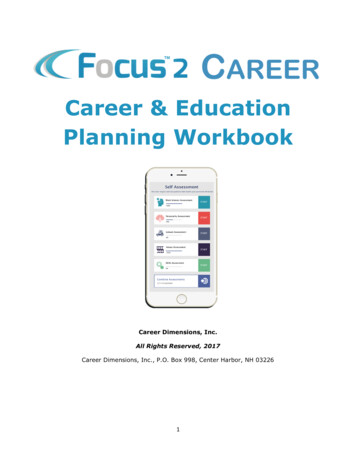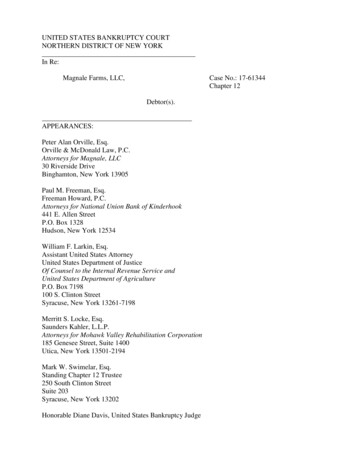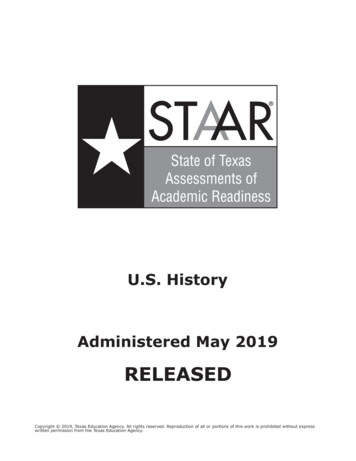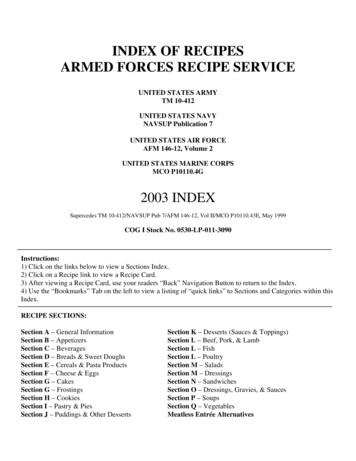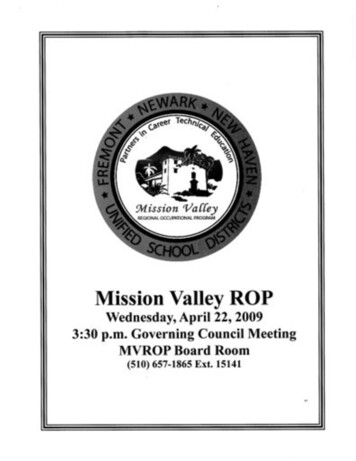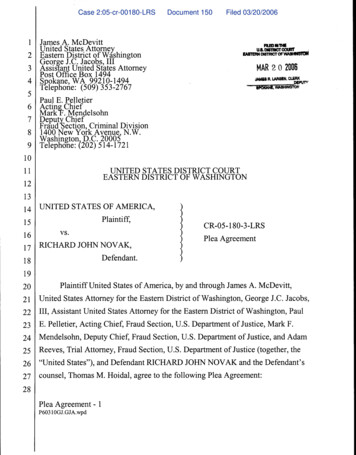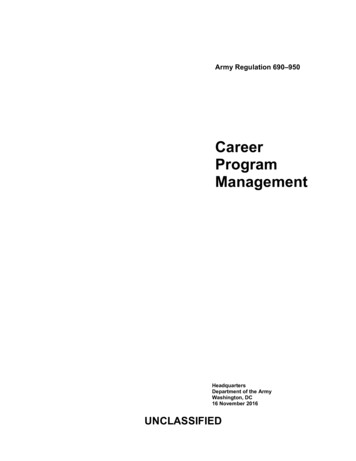
Transcription
Army Regulation ment of the ArmyWashington, DC16 November 2016UNCLASSIFIED
SUMMARY of CHANGEAR 690–950Career Program ManagementThis major revision, dated 16 November 2016-oChanges the title from Career Management to Career Program Management (cover).oDefines and establishes the role of the Army Career Program Proponency in support of the Army mission and itsrelationship to Strategic Human Capital Planning; relocates and redefines the career management objectives to chapter4; defines the goals of the Army Career Program Proponency; restructures the focus from career management to careerprogram management; realigns the details of career program management to chapter 3; defines the Army CareerProgram Proponency System; realigns responsibilities to chapter 2; revises and restructures the Career Program PolicyCommittee (chap 1).oRenames chapter title to responsibilities; deletes merit placement and outside recruitment; establishes roles andresponsibilities to align with civilian workforce transformation outcomes (chap 2).oRenames chapter title to Career Program Enterprise Management; realigns Career Intern Program to chapter 6;establishes career program oversight; updates career program codes; revises and clarifies Army Civilian Training,Education, and Development System Plan requirements and approval process; clarifies career program changeprocedures; incorporates and revises information from previous chapter 4, The Army Acquisition Workforce and/orArmy Acquisition Corps; removes previous chapter 5, Defense Civilian Intelligence Personnel System; incorporatesand revises information from previous chapter 6, Career Program Unique Policies (chap 3).oRenames chapter title to Civilian Strategic Human Capital Planning; introduces strategic human capital planning,strategic workforce planning, and the Army human capital lifecycle; defines the competency management frameworkand process (chap 4).oRenames chapter title to Talent Management; incorporates Senior Enterprise Talent Management and/or EnterpriseTalent Management programs; introduces succession planning; highlights mentoring and coaching (chap 5).oRenames the chapter title to Army Intern Program; reaffirms and clarifies the Army intern program; establishes theArmy Intern Executive Resources Board; revises and restructures the Army Civilian Training, Education, andDevelopment System intern enterprise program management (allocation, selection, and graduate placement); clarifiesArmy intern program management related to promotion eligibility, awards, overtime, permanent change of stationplacement outside the continental United States, and reduction in force; reaffirms and clarifies the PresidentialManagement Fellows Program (chap 6).oRevises internal control evaluation (app B).
HeadquartersDepartment of the ArmyWashington, DC16 November 2016*Army Regulation 690–950Effective 16 December 2016Career Program ManagementProponent and exception authority.The proponent for this regulation is the Assistant Secretary of the Army (Manpowerand Reserve Affairs). The proponent hasthe authority to approve exceptions to thisregulation that are consistent with controlling law and regulation. The proponent maydelegate this approval authority, in writing,to a division chief within the proponentagency or its direct reporting unit or fieldoperating agency, in the rank of colonel orthe civilian equivalent. Activities may request waivers to this regulation by providing justification that includes a full analysisHistory. This publication is a major revi- of the benefits and must include a formalreview by the activity’s legal office. Allsion.waiver requests will be endorsed by theSummary. This regulation provides pol- commander or senior leader of the requesticy for Army Civilian career program man- ing activity and forwarded through theiragement and supports the Army Civilian higher headquarters to the policy proponent. Refer to AR 25–30 for specific guidhuman capital life cycle.ance.Applicability. This regulation applies toall Army Civilian employees to include ap- Army internal control process.propriated fund, nonappropriated fund, di- This regulation contains internal controlrect hire foreign nationals, and federal wage provisions in accordance with AR 11–2 andsystem. Applicability is limited for tempo- identifies key internal controls that must berary and term employees to those activities evaluated (see appendix B).necessary for them to effectively perform intheir current positions. This regulation does Supplementation. Supplementation ofnot apply to National Guard technicians or this regulation and establishment of comIndirect-hire foreign national employees mand and local forms are prohibited withwho are employees of their states and host out prior approval from the Assistant Secretary of the Army (Manpower and Reservenations, respectively.Affairs), 111 Army Pentagon, Washington,DC 20310–0111.Suggested improvements. Users areinvited to send comments and suggestedimprovements on DA Form 2028 (Recommended Changes to Publications and BlankForms) directly to the Assistant Secretaryof the Army (Manpower and Reserve Affairs), 111 Army Pentagon, Washington,DC 20310–0111.Committee management. AR 15–39requires the proponent to justify establishing/continuing committee(s), coordinatedraft publications, and coordinate changesin committee status with the Office of theAdministrative Assistant to the Secretary ofthe Army, Analysis and Integration Cell(AAAI–CL), 105 Army Pentagon, Washington DC, 20310–0105. Further, if it is determined that an established "group" identified within this regulation later takes on thecharacteristics of a committee as found inAR 15–39, then the proponent will followAR 15–39 requirements for establishingand continuing the group as a committee.Distribution. This publication is available in electronic media only and is intendedfor command levels C, D, and E for the Active Army, the Army National Guard/ArmyNational Guard of the United States, andthe U.S. Army Reserve.Contents (Listed by paragraph and page number)Chapter 1Introduction, page 1Section IOverview, page 1Purpose 1–1, page 1References 1–2, page 1Explanation of abbreviations and terms 1–3, page 1Responsibilities 1–4, page 1*This publication supersedes AR 690-950, dated 31 December 2001.AR 690–950 16 November 2016UNCLASSIFIEDi
Contents—ContinuedSection IIArmy Mission and the Army Civilian Corps, page 1Army mission and strategic goal 1–5, page 1Civilian Workforce Vision 1–6, page 1Army Career Program Proponency 1–7, page 1Section IIIArmy Civilian Career Program Proponency Enterprise, page 2Army Civilian Career Program Proponency System 1–8, page 2Army civilian career program management concept 1–9, page 2Chapter 2Responsibilities, page 3Assistant Secretary of the Army (Manpower and Reserve Affairs) 2‒1, page 3Deputy Chief of Staff, G–3/5/7 2‒2, page 5Commanders, Army commands, Army service component commands, and direct reporting units 2‒3, page 5Career program functional chief 2‒4, page 6Career program functional chief representative 2‒5, page 6Career program proponency office 2‒6, page 8Career program planning board 2‒7, page 9Command career program manager 2‒8, page 10Civilian Human Resources Agency 2‒9, page 10Supervisor 2‒10, page 10Army Civilian 2‒11, page 11Chapter 3Career Program Enterprise Management, page 11Section IOverview, page 11Career program management standardization 3‒1, page 11Career program objective 3‒2, page 11Career program oversight 3‒3, page 12Career program structure 3‒4, page 12Section IIArmy Civilian Training, Education, and Development System Plan, page 13Overview 3‒5, page 13Career ladder and career map 3‒6, page 13Army Civilian Training, Education, and Development System Plan approval process 3‒7, page 14Section IIICareer Program Actions, page 14Establishment of a new career program 3‒8, page 14Title change to a career program 3‒9, page 15Career program mapping 3‒10, page 15Career program unique requirements 3‒11, page 15Army Career Tracker 3‒12, page 15Section IVArmy Acquisition Workforce and/or Army Acquisition Corps, page 15Overview 3‒13, page 15Director for Acquisition Career Management 3‒14, page 16Career program and acquisition career field relationship 3‒15, page 16Chapter 4Civilian Strategic Human Capital Planning, page 16iiAR 690–950 16 November 2016
Contents—ContinuedSection IIntroduction, page 16Overview 4‒1, page 16Strategic workforce planning 4‒2, page 16Army Civilian human capital life cycle 4‒3, page 16Section IICompetency Management Framework and Process, page 17Overview 4‒4, page 17Competency management framework 4‒5, page 18Competency-based management process 4‒6, page 19Chapter 5Talent Management, page 20Section ITalent Management, page 20Introduction 5‒1, page 20Talent management and the Career Program Proponency 5‒2, page 20Section IIArmy Civilian Talent Management, page 20Army civilian leader talent management 5‒3, page 20Senior Enterprise Talent Management and/or Enterprise Talent Management programs 5‒4, page 20Section IIISuccession Planning, page 22Overview 5‒5, page 22Objective 5‒6, page 22Succession planning and leadership 5‒7, page 22Succession planning and merit principles 5‒8, page 22Succession planning process 5‒9, page 22Section IVMentoring and Coaching, page 23Overview 5‒10, page 23Mentoring 5‒11, page 23Coaching 5‒12, page 23Chapter 6Army Intern Program, page 24Section IOverview, page 24Introduction 6‒1, page 24Synopsis 6‒2, page 24Types of Army entry-level professional development programs 6‒3, page 24Section IIArmy Civilian Training, Education and Development System Intern Enterprise Program Management, page 24Army Intern Executive Resources Board 6‒4, page 24Army Civilian Training, Education, and Development System recruitment cell 6‒5, page 25Army Civilian Training, Education, and Development System intern manager 6‒6, page 25Army Civilian Training, Education and Development System intern 6‒7, page 25Forecasting and allocations 6‒8, page 25Recruitment 6‒9, page 26Selection 6‒10, page 26AR 690–950 16 November 2016iii
Contents—ContinuedGraduate placement 6‒11, page 26Post-graduation 6‒12, page 27Section IIIArmy Intern Program Management, page 27Army intern vacancy announcements and selections 6‒13, page 27Master Intern Training Plan 6‒14, page 27Performance and recognition 6‒15, page 28Inability to meet performance requirements 6‒16, page 28Promotion requirements 6‒17, page 28Extension of an Army internship 6‒18, page 28Overtime funding 6‒19, page 28Permanent change of station 6‒20, page 28Army Civilian Training, Education, and Development System interns outside the continental United States 6‒21, page 28Intern reduction-in-force guidance 6‒22, page 28Section IVArmy Presidential Management Fellows Program, page 28Overview 6‒23, page 28Program execution 6‒24, page 29AppendixesA. References, page 30B. Internal Control Evaluation, page 33Figure ListFigure 2–1: Career Program Proponency Policy Organization, page 3Figure 2–2: Career Program Organization, page 8Figure 4–1: Army Civilian human capital life cycle, page 17Figure 4–2: DOD Competency Management Construct, page 19GlossaryivAR 690–950 16 November 2016
Chapter 1IntroductionSection IOverview1–1. PurposeThis regulation prescribes policies and responsibilities for developing, managing, and conducting Army Civilian careerprogram management.1–2. ReferencesSee appendix A.1–3. Explanation of abbreviations and termsSee glossary.1–4. ResponsibilitiesResponsibilities are listed in chapter 2.Section IIArmy Mission and the Army Civilian Corps1–5. Army mission and strategic goalThe mission of the Army is to fight and win the Nation’s wars through prompt and sustained land combat, as part of theJoint force. This is accomplished by organizing, equipping, and training Army Forces for prompt and sustained combatincident to operations on land, integrating our capabilities with those of the other Armed Services, accomplishing all missions assigned by the President, Secretary of Defense, and combatant commanders, remaining ready while preparing forthe future. The Army’s strategic goal is to provide the Joint force commander with forces prepared to seize, retain, andexploit the initiative to gain and maintain a position of relative advantage in sustained land operations through simultaneousoffensive, defensive, and stability or defense support of civil authorities operations in order to prevent or deter conflict,prevail in war, and create the conditions for favorable conflict resolution. Army Civilians stand in support of our Soldiers’mission accomplishment and deploy with them across the globe. The Army could not function without a cadre of ArmyCivilian employees who have the passion and dedication to use their unmatched expertise to support and sustain Soldiersand their Families.1–6. Civilian Workforce VisionThis vision is an adaptive and flexible Army Civilian capabilities-based cohort supported by integrated policies, proceduresand programs that produce and deliver the right person, to the right place, at the right time, to support current missions andenable Army 2025 and beyond. An enabler of this vision is the Army Career Program Proponency (CPP) enterprise. Themission of the Army CPP enterprise is to provide a system to realize the full talent of each Army Civilian.1–7. Army Career Program ProponencyThe Army CPP provides structured plans, processes, and activities directing and supporting the systematic organizational,occupational, and individual growth of Army Civilians in designated career programs throughout the civilian human capitallife cycle. It entails progression through a series of training, education, and professional development (TE&PD) programsand assignments involving broader knowledge, improved skills, and/or greater responsibility. An essential cornerstone toCPP is Strategic Human Capital Planning (SHCP). SHCP provides a prescriptive methodology to assess the current stateof the workforce, identify skill and competency gaps and strengths, and forecast emerging and future workforce requirements, including those of an expeditionary nature, as part of Total Army planning. The CPP provides each Army Civilianwith the capability to define career goals by identifying career developmental paths and competency-based training plans.AR 690–950 16 November 20161
Section IIIArmy Civilian Career Program Proponency Enterprise1–8. Army Civilian Career Program Proponency SystemThe Army CPP System institutionalizes the deliberate development of Army Civilians. This system continually monitorsand assesses the current capabilities of the Army Civilian workforce and program requirements. Specifically, the system—a. Establishes and sustains the Army Profession and the Army Civilian Corps.b. Provides a holistic and systematic approach to manage the technical and leadership development of Army Civiliansthroughout the human capital life cycle.c. Supports civilian functional manpower requirements analyses incident to Total Force planning and the strategiesneeded to build the Army Civilian workforce to meet those requirements.d. Identifies required competencies and competency proficiency levels for employees to meet current and future missions and communicates those requirements to appropriate stakeholders (see paras 4–4 through 4–6).e. Compares the current competency level requirements to the current proficiency levels to determine current competency gaps and gap closure methodologies.f. Identifies career paths in order to provide a competency-based career map for Army Civilians to enhance their careerplanning and development.1–9. Army civilian career program management conceptThe Assistant Secretary of the Army (Manpower and Reserve Affairs) (ASA (M&RA)) is the lead proponent for ArmyCivilian career program management and assigns staff proponency to the Deputy Assistant Secretary of the Army (CivilianPersonnel) (DASA (CP)).a. The Career Program Policy Committee. The CPPC is a biannual intra-Army departmental committee established toprovide a systematic process to identify and resolve issues, determine priorities, and make decisions to support the CPP.Chaired by the DASA (CP), the members of the CPPC serve as the senior advisory group to recommend changes andimprovements to career program policy and procedures. The CPPC forwards policy recommendations through DASA (CP)for the ASA (M&RA) concurrence and coordination with the appropriate Army Staff. All CPPC recommendations willconsider policy implications, impact if not adopted, general resource requirements, and general priority in relationship toother Army initiatives. The CPPC ensures the CPP can sustain the requisite readiness of the Army Civilian Corps.(1) Primary CPPC membership consists of all career programs represented by its functional chief (FC) or their designated representative. All CPPC primary members are voting members.(2) Advisory CPPC membership consists of the Assistant Deputy Chief of Staff (ADCS), G–3/5/7 Director of Training,and the command G1/human resources directors from the U.S. Army Forces Command (FORSCOM); the U.S. ArmyTraining and Doctrine Command (TRADOC); the U.S. Army Materiel Command (AMC); the U.S. Army InstallationManagement Command (IMCOM); the U.S. Army Medical Command (MEDCOM); the U.S. Army Corps of Engineers(USACE); and the Director, Civilian Human Resources Agency (CHRA). Advisory CPPC members are nonvoting members.(3) The CPPC chair may invite Headquarters, Department of the Army (HQDA) and Joint general officers or seniorexecutives to attend.(4) The CPPC meets at least twice annually with a spring CPPC and a fall CPPC.(5) Travel and per diem costs associated with CPPC are the responsibility of the home station organization of the attendee.b. Working groups. The CPPC chair may establish working groups (WGs) to support the CPPC or other special CPPenterprise initiatives. Each WG assists the CPPC to accomplish its responsibilities and will forward appropriate issuesfrom its area of interest to the CPPC.(1) The CPPC recommends the WG composition and size to the DASA (CP) for approval. The WG composition willvary and may include career program and command representatives.(2) DASA (CP) provides guidance to each WG.(3) DASA (CP) Civilian Career Proponency Division (CCPD) chairs each WG and may invite subject matter experts,as needed.2AR 690–950 16 November 2016
Chapter 2Responsibilities2‒1. Assistant Secretary of the Army (Manpower and Reserve Affairs)The ASA (M&RA) is the proponent for career program management and is responsible for Army Civilian SHCP and acompetency-based workforce planning system to ensure the readiness of the Army Civilian Corps to meet mission requirements. The ASA (M&RA) will—a. Approve career program management policy, guidance, and strategies. See figure 2–1 for the CPP organizationalstructure.Figure 2–1. Career Program Proponency Policy Organizationb. Promote sufficient investments in Army Civilian TE&PD opportunities targeted to maximize overall return on investment.c. Lead and integrate SHCP, including workforce capability and readiness efforts, within the framework of Total Forceplanning.d. Provide SHCP and forecasting oversight (as the Army integrator).e. Appoint component functional community managers (CFCMs) to assist the Office of the Secretary of Defense Functional Community Managers (OFCMs) on Department of Defense (DOD) DOD-wide career program management issues.CFCMs will work with the OFCMs in ensuring their respective career program communities have the skills needed tosupport both the DOD and Army mission.AR 690–950 16 November 20163
f. Appoint FCs to support career program management and to participate in the CPPC on enterprisewide issues.g. Consider CPPC recommendation(s).h. Consider the recommendation(s) of the Army Civilian Training, Education, and Development System (ACTEDS)Intern Executive Resources Board (AIERB) and annually approve the final ACTEDS intern allocation.i. Issue guidance for meeting the annual reporting requirements in accordance with the National Defense AuthorizationAct and any other SHCP-related reporting requirements (for example, the Equal Employment Opportunity Commissionmandated Management Directive-715 report).j. On behalf of the ASA (M&RA), the DASA (CP) is the staff proponent responsible to monitor the integration of SHCPinto the full spectrum of the Army civilian human capital life cycle management within career programs, and in so doing,will confer with FCs, functional chief representatives (FCRs), command leadership, and human resources (HR) and manpower authorities. The DASA (CP) will—(1) Serve as the Army’s principal advisor and lead facilitator on career program policy and resource requirements related to civilian career program management.(2) Monitor the strategic environment, workforce and demographic diversity trends, competency assessments, and gapanalyses to ensure that recruitment, retention, and development initiatives address current and future mission requirements,including those of an expeditionary nature.(3) Establish career programs for functional proponency by occupation and across occupations as necessary to meetSHCP needs and to facilitate Army civilian life cycle management.(4) Develop and establish career program management policies, procedures, and program requirements.(5) Develop and establish policies, procedures, and program requirements for issues relating to SHCP and forecasting.(6) Function as the lead agent and the chair for the CPPC and the AIERB. The CPPC convenes biannually (spring andfall). For further information see paragraph 1–9a.(7) Facilitate working groups to support CPPC and career program proponency initiatives.(8) Provide technical support to the career program proponency offices (CPPOs) and monitor their staffing levels foroptimal support to career program management.(9) Establish and execute an internal control evaluation to provide feedback to Army leadership and the CPP communityregarding the compliance and effectiveness of Army career program management.(10) Serve as the Army lead proponent for competency development and utilization.(11) Monitor and evaluate effectiveness of gap mitigation strategies as identified by FCRs based upon command feedback.k. Review and approve all ACTEDS plans submitted by FCRs.l. Through the CCPD, the ACTEDS Intern Program Management Office (IPMO) provides oversight and overall program management of the ACTEDS intern program. Specifically, the IPMO will—(1) Forecast proposed annual ACTEDS intern allocations for each career program.(2) Chair the AIERB.(3) Coordinate the review and approval of the AIERB recommended final ACTEDS intern allocation by the ASA(M&RA).(4) Recommend changes to the policy and procedures for managing ACTEDS interns as a strategic asset.(5) Coordinate with FCRs and recommend to ASA (M&RA) the reallocation of ACTEDS intern authorizations that arenot fully executed by career programs based on program requirements.(6) Allocate ACTEDS resources to support costs of salary and related travel, training, education, and development forACTEDS interns and for ACTEDS intern program administrative costs.(7) Review and approve permanent change of station (PCS) orders when necessary for initial entry on duty and/orpermanent placement of ACTEDS interns.(8) When necessary, and in coordination with FCRs, commands, and the CHRA, direct the placement of surplusACTEDS centrally-funded interns in appropriate Armywide vacancies.(9) Approve requests as needed to continue to carry an ACTEDS intern on the centralized ACTEDS intern account forup to 120 days beyond the initial 2 years. For further information see paragraph 6–18.(10) Monitor the execution and management of the ACTEDS intern program and take corrective actions, as needed.(11) Evaluate the effectiveness of the ACTEDS intern program including its impact as a succession source for futurefunctional and enterprise leadership positions.(12) Evaluate and approve, reject, or staff for approval any requested deviation from procedures described in this policyand its enclosures. Coordinate policy changes needed to improve the ACTEDS intern program with the CPPC prior togaining ASA (M&RA) approval for the policy change.(13) Assess the effectiveness of strategies in reducing functional competency gaps.(14) Communicate career program management initiatives to all stakeholders with frequency.4AR 690–950 16 November 2016
(15) Ensure the Army remains informed of other DOD component and external agency initiatives (governmental andnongovernmental), partnering with them on human capital efforts as appropriate and applicable.(16) Ensure that career program proponency staffs are trained and have the capability to perform assigned responsibilities.2‒2. Deputy Chief of Staff, G–3/5/7On behalf of the Deputy Chief of Staff (DCS), G–3/5/7, the ADCS, G–3/5/7 will—a. Formulate training policies and centrally manage program resources to include ACTEDS.b. Identify effective and efficient delivery of training to meet training requirements for the Army Civilian Corps.c. Develop and manage training policy and training procedures for civilians in military and civilian institutions.d. Manage the enterprise-level civilian training requirements to meet the short and long-term Army and DOD trainingmanagement goals and/or objectives.e. Validate civilian functional ACTEDS plan training requirements identified by DASA (CP) as submitted by FCR anddevelop programming and budget data.f. Allocate ACTEDS training funds for competitive professional development based on validated training requirementsand manage the execution of those funds.g. Validate eligibility of career program and command nominations for Army enterprise competitive training.h. Prioritize Army enterprise training allocations for constrained resources during the year of execution and during theprogram objective memorandum (POM) years.i. Serve as a member of the CPPC.j. Report competitive training to Office of the Secretary of Defense (OSD), Office of Personnel Management (OPM),and other key stakeholders, as required.k. Serve as the Army Staff proponent for managing all mandatory civilian training requirements.l. Serve as the Army’s liaison to OPM and DOD, as delegated by the ASA (M&RA), to ensure compliance with andimplementation of training and leader development policy and program development as defined by Office of Managementand Budget directives and statutory requirements and monitor impacting legislation and coordinates with DASA (CP).Maintain civilian training data, an enterprise training management system, and report to OSD, OPM, and Congress, asdirected.m. Establish new training strategies that accommodate emergence of new Armywide workforce development programs,distance learning, delegated authority and its effect on training program analysis, evaluation, and cost effectiveness.2‒3. Commanders, Army commands, Army service component commands, and direct reporting unitsThe Commanders of ACOMs, ASCCs, and DRUs will—a. Implement and execute SHCP and succession planning that complements CPP and the Army Civilian human capitallife cycle.b. Ensure staff, to include HR staff and command career program managers (CCPMs), communicates, coordinates, andcollaborates frequently with career program proponency staff to ensure their situational awareness and understanding ofthe current and future Total Force mission requirements at all organizational levels.c. Establish a learning culture that encourages and supports employee participation in TE&PD programs and assignments and mentoring opportunities.d. Facilitate and support CPP activities related to gathering data and understanding the implications related to theirstrategic environment, workforce and demographic diversity trends, competency assessments, and gap analyses.e. Provide subject matter experts to perform job analysis for competency assessments. Ensure representation of theircivilian workforce at FCR strategic planning meetings for which their Army Civilian workforce is representative of thecareer program population.f. As advisors to commanders or agency heads, the command human resources director and/or G–1 advises all levelsof the command and career program management structure on strategies that will facilitate the achievement of humancapital goals. Command human resources directors will—(1) Consult with leadership on the strategic objectives of the organization or activity, including new mission requirements and business processes, and the TE&PD opportunities necessary to accomplish those objectives.(2) Identify organizational change initiatives and develop and implement change management plans to facilitate organizational development.(3) Develop and implement local policy, procedures, and information requirements for TE&PD for employees.(4) Collaborate and consult with FCRs on TE&PD issues related to strategic human capital and succession planning.(5) Serve as an AIERB member.AR 690–950 16 November 20165
Note: Home station organization is responsible for travel and per diem funding requirements for on-site meeting attendance. On-site attendance is highly encouraged and recommended.(6) Coordinate with FCRs and/or CPPOs to support the management and operational requirements of the ACTEDSintern enterprise program.(7) Participate in DASA (CP) and ADCS, G–3/5/7 board, committee, or any meeting that involves TE&PD discussion,recommendation, and/or decisionmaking outcomes.(8) Assist, collaborate, and consult with CCPMs.(9) Assist supervisors of Army Civilian employees with competency gap assessments and advise them on strategies toclose identified competency levels.(10) Advise supervisors and Army
Contents—Continued iv AR 690–950 16 November 2016 Graduate placement 6‒11, page 26 Post-graduation 6‒12, page 27 Section III Army Intern Program Management, page 27 Army intern vacancy announcements and selections 6‒13, page 27 Master Intern Training Plan 6‒14, page 27 Performance and re



